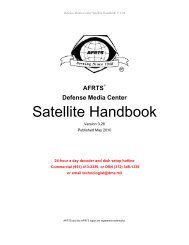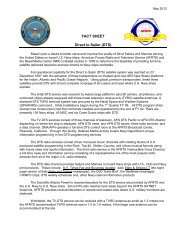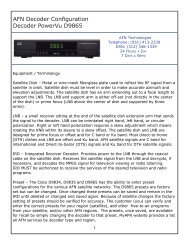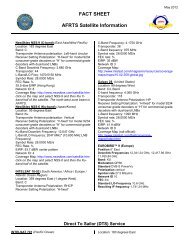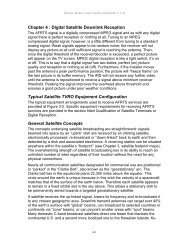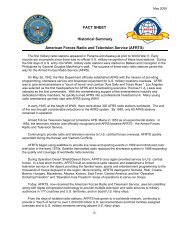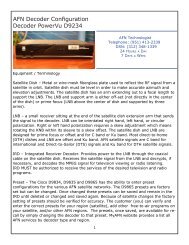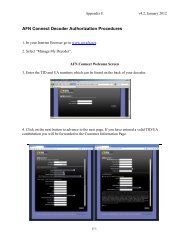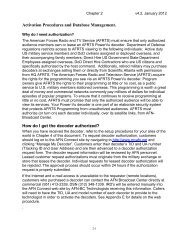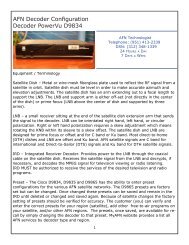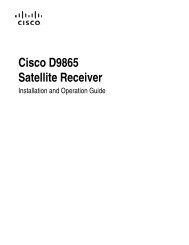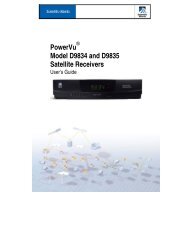AFRTS Defense Media Center Satellite Handbook
AFRTS Defense Media Center Satellite Handbook
AFRTS Defense Media Center Satellite Handbook
Create successful ePaper yourself
Turn your PDF publications into a flip-book with our unique Google optimized e-Paper software.
Protection from Interference<br />
<strong>Defense</strong> <strong>Media</strong> <strong>Center</strong> <strong>Satellite</strong> <strong>Handbook</strong> V.3.26<br />
Selecting a site<br />
Site selection is the most important pro-active stop an earth station operator can<br />
take in prevention of terrestrial interference. Busy roads and highways, parking<br />
lots, power generators, and power equipment near the receiving antenna are all<br />
potential sources of interference. Sites located near airports may need special<br />
consideration due to aircraft radar altimeters.<br />
Saturation and Compression<br />
Many traditional earth station operators in the analog environment are concerned<br />
with obtaining the highest signal level possible for their analog receiving<br />
equipment High signal levels in the digital environment can be problematic where<br />
terrestrial interference is present<br />
Ignition noise is a common problem where saturation can occur in the RF path.<br />
Interfering carriers can potentially be 40 dB higher than the satellite carrier<br />
resulting in compression of the RF subsystems.<br />
Optimizing signal levels through the use of C-band and L-band attenuator pads<br />
to increase the “headroom” of the system where RFI is found can dramatically<br />
improve performance of the receiving equipment. Installation of 6dB and 10dB<br />
pads in front of line amplifiers, block down converters, and video<br />
receiver/decoders can provide the additional “headroom” needed to prevent<br />
saturation during a RFI hit. Operating IRD’s in a “low gain” mode is another<br />
useful way to add additional “headroom” for RFI “hits”.<br />
Many earth station operators utilize line amplifiers in traditional analog systems,<br />
which can aggravate the effect of RFI and compression. Signals that are spiked<br />
due to RFI in combination with a high gain line amplifier can saturate<br />
downstream block down converters and RF tuners inside the IRD. Optimization<br />
of the RF path, including line amplifiers is necessary when combating RFI.<br />
Out-of-band Filtering<br />
For sites experiencing aircraft radar or out-of-band interference, C-band filtering<br />
in front of the LNA/LNB is an effective way to protect from interfering carriers.<br />
Special notch filters have been made for aircraft radar that are effective in those<br />
specific locations near airports or aircraft approaches.<br />
RFI (Radio Frequency Interference) Fencing<br />
Special RFI fencing can often reduce the source of interfering carriers or ignition<br />
noise where it is present Wire fences of the proper diameter, located between the<br />
interfering source and the earth station antenna can be an effective way of<br />
dealing with terrestrial interference. Fences that can be utilized for RFI protection<br />
can be as simple as fine wire mesh of galvanized steel, property grounded that<br />
roughly meets the desired dimensions of 1/10 wavelength beyond cutoff of the Cband<br />
carrier. It is important to install the fence at the proper height and distance<br />
4-17



